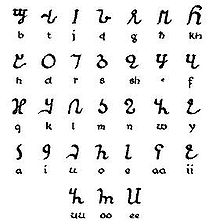Somali alphabets

A number of writing systems have been used over the years to transcribe the Somali language. Of these, the Somali Latin alphabet is the most widely used. It has been the official writing script in Somalia since the Supreme Revolutionary Council formally introduced it in October 1972, and was disseminated through a nationwide rural literacy campaign.[1] Prior to the twentieth century, the Arabic script was used for writing Somali. An extensive literary and administrative corpus exists in Arabic script.[2][3] It was the main script historically used by the various Somali Sultans to keep records.[3] Writing systems developed locally in the twentieth century include the Osmanya, Borama and Kaddare scripts.[4]
Latin script

The Somali Latin script, or Somali Latin alphabet, was developed by the Somali linguist Shire Jama Ahmed specifically for the Somali language. It uses all letters of the English Latin alphabet except p, v and z, and has 21 consonants and 5 vowels. There are no diacritics or other special characters, except the use of the apostrophe for the glottal stop, which does not occur word-initially. Additionally, there are three consonant digraphs: DH, KH and SH. Tone is not marked, and front and back vowels are not distinguished. Capital letters are used at the beginning of a sentence and for proper names.
A number of attempts had been made from the 1920s onwards to standardize the language using a number of different alphabets. Starting from 1960, debate about which writing system to use for transcribing the Somali language dragged on for nine years. No fewer than a dozen linguists were tasked with developing a workable script. Eventually, Shire Jama Ahmed's refined Somali Latin script was adopted, an alphabet which he used to publish pamphlets and small Af Soomaali drillbooks in his own printing press. Ahmed argued that even though most people were in favor of using the Arabic script, it was more practical to use Latin primarily due to its simplicity, the fact that it lent itself well to writing Somali since it could cope with all of the sounds in the language, and the already widespread existence of machines and typewriters designed for its use.[5] Pamphlets explaining the new standardization were released to the public in a soccer stadium in Mogadishu on October 10, 1972.
Arabic script

Before the arrival of the Italians and British, Somalis and religious fraternities either wrote in Arabic or used an ad hoc transliteration of Somali into Arabic script referred to as Wadaad's writing. It contains 32 letters, 10 of which are vowels. The remaining 22 are consonants.[6]
According to Bogumil Andrezewski, this usage was limited to Somali clerics and their associates, as sheikhs preferred to write in the liturgical Arabic language. Various such historical manuscripts in Somali nonetheless exist, which mainly consist of Islamic poems (qasidas), recitations and chants.[7] Among these texts are the Somali poems by Sheikh Uways and Sheikh Ismaaciil Faarah. The rest of the existing historical literature in Somali principally consists of translations of documents from Arabic.[8]
Osmanya script
The Osmanya alphabet, also known as Far Soomaali ("Somali writing"), is a writing script created to transcribe the Somali language. It was invented between 1920 and 1922 by Osman Yusuf Kenadid of the Majeerteen Darod clan, the nephew of Sultan Yusuf Ali Kenadid of the Sultanate of Hobyo (Obbia). A phonetically sophisticated alphabet, Kenadid devised the script at the start of the national campaign to settle on a standard orthography for Somali.[9]
Borama script
The Borama alphabet (Gadabuursi script) was devised around 1933 by Abdurahman Sheikh Nuur of the Gadabuursi clan.[10] Though not as widely known as Osmanya, it produced a notable body of literature mainly consisting of qasidas.[2] A quite accurate phonetic writing system,[10] the Borama script was principally used by Nuur and his circle of associates in his native city of Borama.[10][6]
Kaddare script
The Kaddare alphabet was invented in 1952 by Hussein Sheikh Ahmed Kaddare of the Abgaal Hawiye clan. A phonetically robust writing system, the technical commissions that appraised the script concurred that it was a very accurate orthography for transcribing Somali.[11] Several of Kaddare's letters are similar to those in the Osmanya alphabet, while others bear a resemblance to Brahmi.[12]
Notes
- ^ Economist Intelligence Unit (Great Britain), Middle East annual review, (1975), p.229
- ^ a b I.M. Lewis (1958), The Gadabuursi Somali Script, Bulletin of the School of Oriental and African Studies, University of London, Vol. 21, pp. 134–156.
- ^ a b Sub-Saharan Africa Report, Issues 57-67. Foreign Broadcast Information Service. 1986. p. 34.
- ^ Laitin, David D. (1977). Politics, Language, and Thought: The Somali Experience. University of Chicago Press. pp. 87–88. ISBN 0226467910.
- ^ Andrew Simpson, Language and National Identity in Africa, (Oxford University Press: 2008), p.288
- ^ a b "Somali (af Soomaali / اَف صَومالي˜)". Omniglot. Retrieved 17 October 2013.
- ^ Andrezewski, B. W. In Praise of Somali Literature. Lulu. pp. 130–131. ISBN 1291454535. Retrieved 17 January 2015.
- ^ Andrezewski, B. W. In Praise of Somali Literature. Lulu. p. 232. ISBN 1291454535. Retrieved 17 January 2015.
- ^ Wasaaradda Warfaafinta iyo Hanuuninta Dadweynaha (1974). The Writing of the Somali Language. Ministry of Information and National Guidance. p. 5.
- ^ a b c David D. Laitin (1 May 1977). Politics, Language, and Thought: The Somali Experience. University of Chicago Press. pp. 98–. ISBN 978-0-226-46791-7. Retrieved 2 July 2012.
- ^ Laitin, David D. (1977). Politics, Language, and Thought: The Somali Experience. University of Chicago Press. p. 87. ISBN 0226467910.
- ^ Simon Ager, Kaddare transcription

